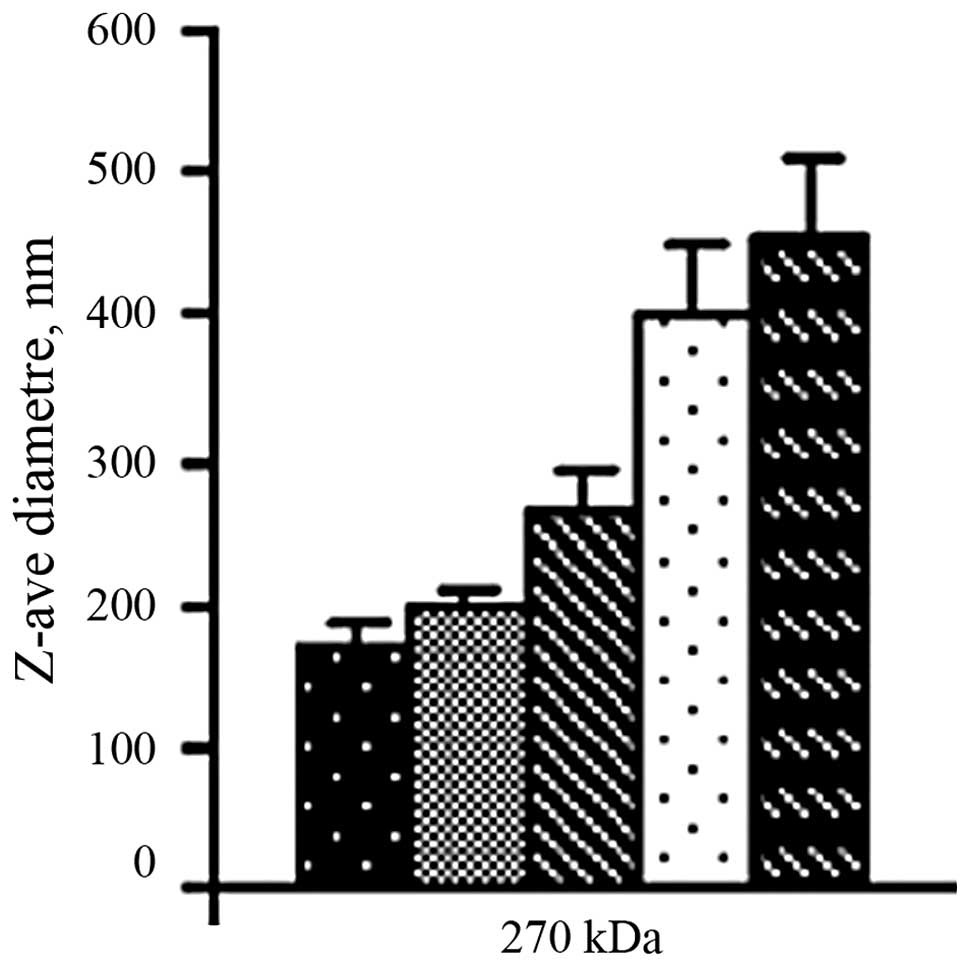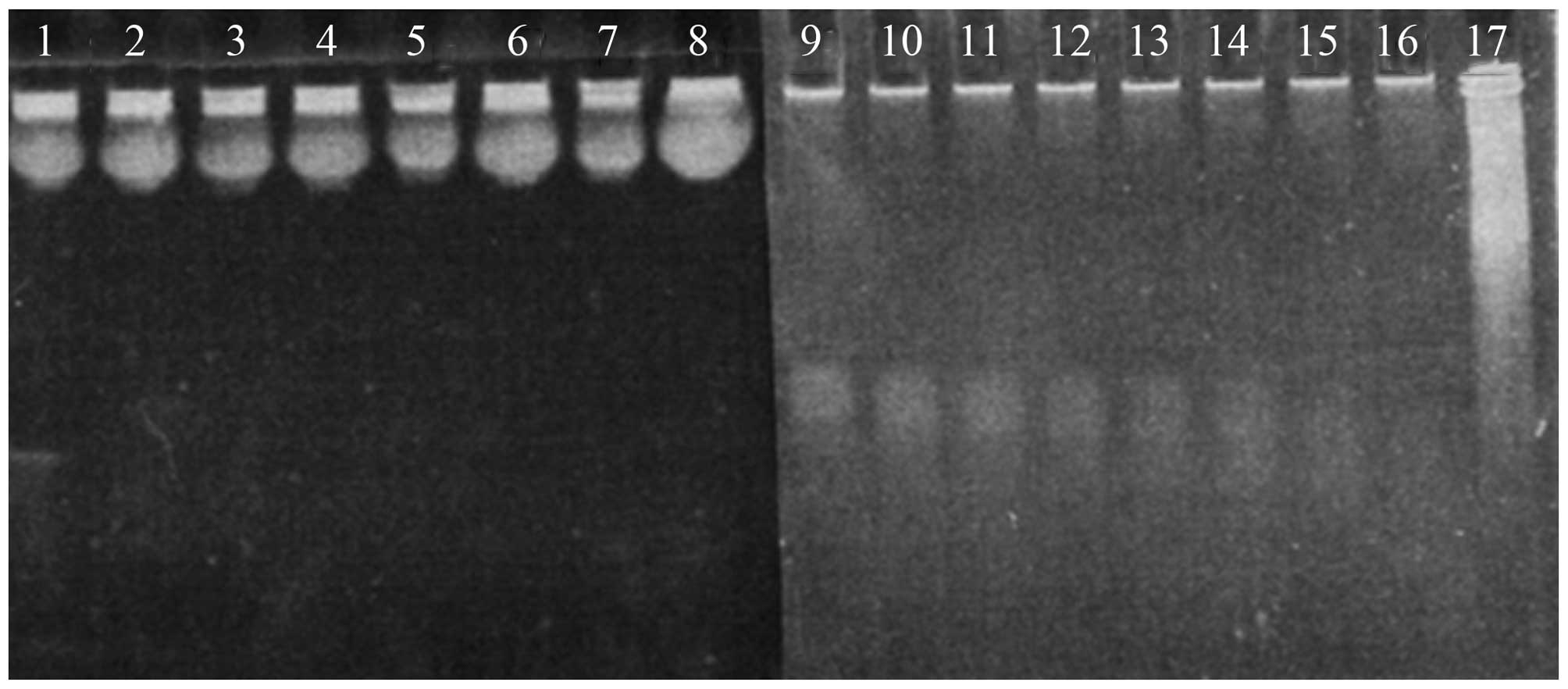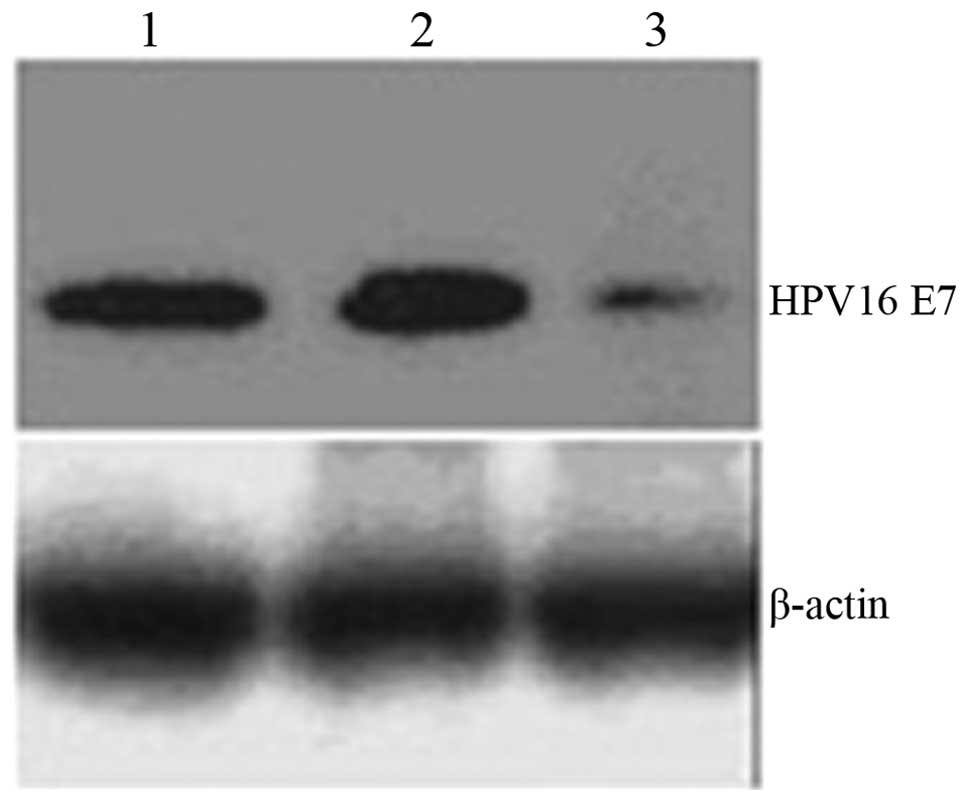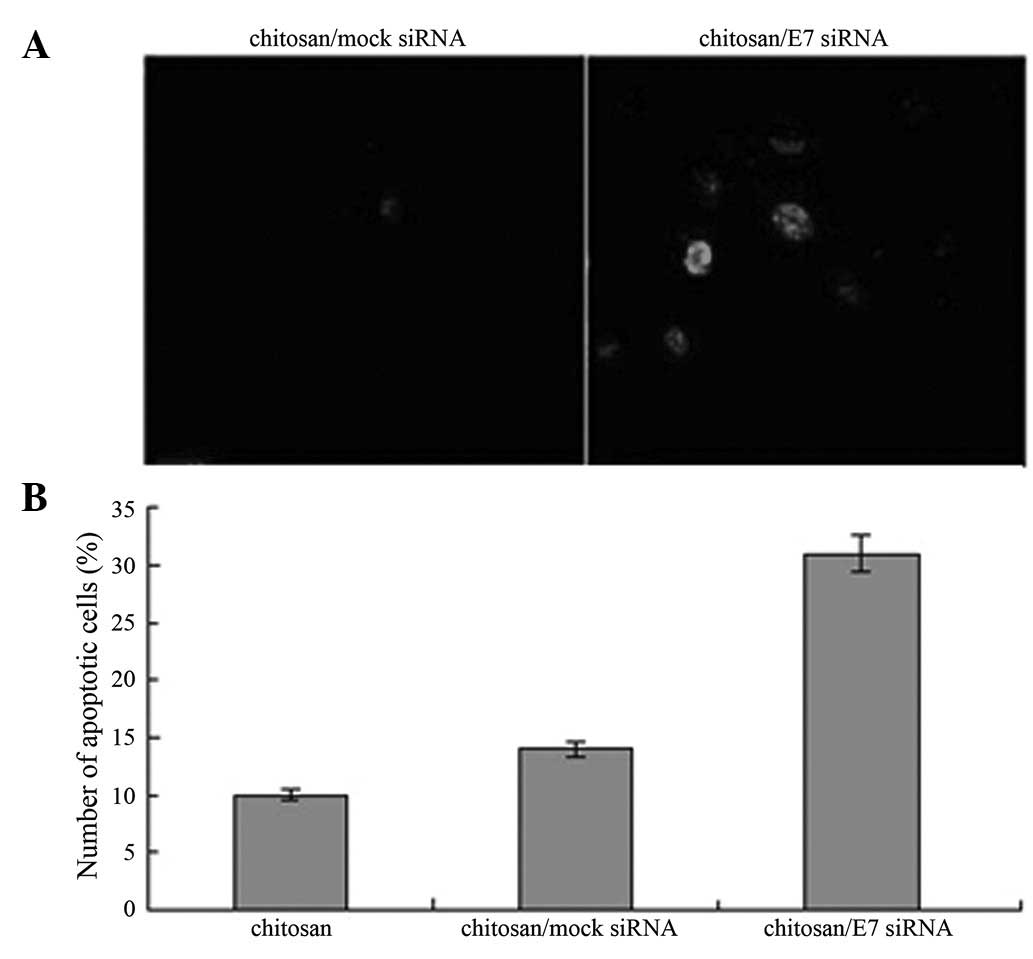Induction of apoptosis by chitosan/HPV16 E7 siRNA complexes in cervical cancer cells
- Authors:
- Published online on: December 20, 2012 https://doi.org/10.3892/mmr.2012.1246
- Pages: 998-1002
Abstract
Introduction
Cervical cancer is a malignant tumor and the second most malignant cancer in females. It is a major threat to female health worldwide. Globally, 500,000 new cases and >250,000 mortalities occur each year. These figures account for ~5% of all cancer cases worldwide with ~80% of new cases reported in developing countries (1). In China, the annual incidence of new cervical cancer cases exceeds 130,000, accounting for 28.8% of new cases worldwide (2). An estimated 20,000 individuals succumb to cervical cancer every year in China, and incidence is increasing in young adults (3).
The most important risk factor for cervical cancer is infection with human papilloma virus (HPV), which accounts for 50–70% of all cervical cancer cases worldwide. Oncoproteins encoded by two early HPV genes, E6 and E7, are important for cell cycle control. E6 and E7 are required for malignant transformation and maintenance of malignant phenotypes and are crucial for the development and progression of cervical cancer (4–8). HPV16 E7 binds to key tumor suppressors and inhibits their activity. One of the most important targets of HPV16 E7 is the retinoblastoma protein (pRb) family which contains pRb, p107 and p130. In normal cells, pRb proteins are major regulators of the cell cycle, binding directly to the E2F transcription factor and negatively regulating its activity, thus inhibiting expression of E2F target genes important for cell cycle progression (9–16). In HPV16 E7-overexpressing cells, HPV16 E7 binds to pRb via its CR3 region. This binding induces pRb degradation through the ubiquitin-proteasome system and releases E2F into the cytosol (17–20). The free E2F translocates to the nucleus, activates the transcription of its target genes and promotes cell transformation. Therefore, suppression of HPV16 E7 expression is likely to inhibit cell growth and induce apoptosis and senescence, which may limit the growth of cancer cells.
RNA interference (RNAi) has become widely used as an experimental tool to analyze gene function and holds great promise in the field of gene therapy in cancer. However, several limitations restrict its use in basic research and clinical application. First, siRNA is not stable and is easily degradated by enzymes. Second, the delivery of siRNA into cells is a great challenge. Although liposome and cationic polymers have been used as carriers for siRNA delivery, these reagents are toxic to cells and not suitable for in vivo transfection. Chitosan is derived from chitin, the most abundant biopolymer in nature following cellulose and is a biologically safe, non-toxic, biodegradable and biocompatible polymer. It contains abundant -NH2 groups and is therefore positively charged at specific pH levels, enabling it to complex with negatively charged nanoparticles (21,22). In the present study, chitosan was utilized as a carrier for delivery of HPV16 E7 siRNA into CaSki cells constitutively expressing HPV16 E6 and E7. The effect of chitosan/siRNA nanoparticles on the induction of apoptosis in these cells was examined. Results indicate a potential use of chitosan/siRNA complexes in the treatment of diseases, including cervical cancer.
Materials and methods
Materials
Chitosan was purchased from Jinan Haidebei Marine Bioengineering Co., Ltd. (Jinan, China). The degree of deacetylation was 86%. The following siRNA oligos for HPV16 E7 were used: sense, GCATGGAGATACACCTACA and antisense, TGTAGGTGTATCTCCATGC (synthesized by Shanghai Generay Biotech Co., Ltd., Shanghai, China). The study was approved by the ethics committee of the Third Affiliated Hospital of Xinxiang Medical University, Xinxiang, Henan Province, China.
Preparation and characterization of chitosan/siRNA nanoparticles
Chitosan was dissolved in aqueous acetic acid (0.1 M sodium acetate/0.1 M acetic acid, pH 4.5) to prepare various concentrations of chitosan solution (25–300 μg/ml). Chitosan/siRNA nanoparticles were prepared by adding a chitosan solution drop-wise to an equal volume of siRNA solution (20 μg/ml) and incubating at room temperature for 30 min. The chitosan was complexed with siRNA at a weight ratio of 1.25:1–15:1. The size and ζ potential of nanoparticles were measured using the submicron particle analysis system 4700 (Beckman Coulter Inc., Miami, FL, USA) and the Zetasizer Nano S (Malvern Instruments, Malvern, UK), respectively.
Measurement of siRNA loading efficiency
Chitosan and siRNA were mixed and the mixture was centrifuged and the absorbance of supernatant was measured at 260 nm to determine the concentration of free siRNA. The loading efficiency of siRNA was calculated by comparing the amount of siRNA that was not present in the supernatant to the amount of total siRNA.
Gel retardation assay
The binding of siRNA to chitosan was determined by electrophoresis using a 4% agarose gel (low melting point). Nanoparticles with various chitosan/siRNA weight ratios were loaded onto the gel and subjected to electrophoresis. siRNA was visualized by ultraviolet light.
Serum stability assay
Chitosan/siRNA nanoparticles (~5 μg siRNA, 200 μl) were incubated with an equal volume of 20% fetal bovine serum (FBS) in Dulbecco’s modified Eagle’s medium (DMEM) at 37°C. At various time points (0, 0.5, 2, 4, 7, 24, 48 and 72 h), 30 μl mixture was saved and stored at −20°C.
Characterization of the biological activity of chitosan/siRNA nanoparticles
CaSki cells were seeded in 96-well plates at a density of 3×104 cells/well and cultured in DMEM containing 10% FBS (no antibiotics) for 24 h prior to transfection. Chitosan/siRNA particles were added directly into the culture medium and the cells were cultured for an additional 24–48 h prior to examination by fluorescence microscopy.
Cell toxicity assay
Toxicity of chitosan was determined by the cell viability of chitosan/siRNA nanoparticles, as described previously (23).
TUNEL staining
CaSki cells were seeded in 96-well plates at a density of 3×104 cells/well and cultured in DMEM containing 10% FBS (no antibiotics) for 24 h prior to transfection. Chitosan/siRNA particles were added directly to the culture medium and the cells were cultured for an additional 24–48 h. Cell death was detected using an in situ Cell Death Detection kit (Nanjing KeyGen Biotech, Co., Ltd., Nanjing, China).
Western blot analysis
CaSki cells were seeded in 6-well plates at a density of 4×104 cells/well. Following plating (24 h), cells were fed with fresh complete media and the chitosan/siRNA nanoparticles were added to the media. Following an additional 48 h, cells were harvested with RIPA buffer. Samples were subjected to SDS-PAGE and immunoblotted with antibodies against HPV16 E7 and β-actin (Santa Cruz Biotechnology, Inc., Santa Cruz, CA, USA).
Statistical analysis
Data were analyzed using SPSS 11.0 (SPSS Inc., Chicago, IL, USA) and expressed as mean ± SE. P<0.05 was considered to indicate a statistically significant difference.
Results
Size of chitosan/siRNA nanoparticles
The chitosan/siRNA particles formed by simple complexation had a diameter between 185 and 465 nm and the size increased with the increasing weight ratio of chitosan to siRNA (Fig. 1).
Surface charge
As revealed in Table I, the surface charge of chitosan/siRNA particles increased with increasing chitosan concentration (the amount of siRNA remained constant). Increased chitosan concentration increased the positive charge of the particles, preventing aggregation of the particles and enhancing their interaction with negatively charged cell membranes.
Interaction of siRNA with chitosan
Since chitosan and siRNA carry opposite charges, they are attracted to one another in solutions with specific pH values. Complete attachment of siRNA to chitosan was observed when chitosan and siRNA were mixed at a weight ratio of 100:1 (Fig. 2). The loading efficiency of siRNA was 72±1.5%.
Stability of siRNA in serum
Naked siRNA was not stable in serum and was susceptible to enzyme digestion. When complexed with chitosan, the rate of degradation was markedly reduced (Fig. 3), indicating that chitosan protects siRNA from nuclease attack.
Biological activity of chitosan/siRNA nanoparticles
To examine the transfection efficiency of chitosan/siRNA nanoparticles, chitosan was complexed with fluorescence-labeled HPV16 E7 siRNA and their accumulation in CaSki cells was monitored. As demonstrated in Fig. 4, chitosan/siRNA particles were efficiently tranfected into cells following 24-h incubation. Protein levels of HPV16 E7 in CaSki cells were analyzed by western blot analysis and identified to be significantly downregulated (Fig. 5; P<0.05), indicating that chitosan/HPV16 E7 nanoparticles suppress expression of HPV16 E7.
Induction of apoptosis in CaSki cells by chitosan/HPV16 E7 nanoparticles
To examine the effect of chitosan/HPV16 E7 nanoparticles on cell apoptosis, apoptotic cells were detected using the TUNEL assay in cells treated with chitosan/HPV16 E7 nanoparticles. A significantly higher number of apoptotic cells were detected in cells treated with chitosan/HPV16 E7 nanoparticles compared with cells treated with chitosan/mock siRNA particles (Fig. 6; P<0.05).
Discussion
In the present study, chitosan/siRNA nanoparticles were prepared by simple complexation (24). The size and shape of nanoparticles is critical for efficient transfection of mammalian cells and distribution of nanoparticles in living cells (25). Previous studies have reported that nanoparticles exhibit higher levels of intracellular uptake compared with microparticles (26–28). This property is crucial for gene transfer, since the uptake of chitosan/DNA nanoparticles and their release from lysosomes are rate-limiting steps in this process (29,30). Similar to DNA and oligodeoxyribonucleotides, siRNA is also taken up by cells (31). However, RNAi is not induced if siRNA fails to reach the cytoplasm (31). Using a carrier aids siRNA transfer into the intracellular compartment and protects it from enzyme degradation in lysosomes, thus efficiently inducing RNAi. In the present study, chitosan/siRNA nanoparticles were prepared with a size <500 nm in diameter which were easily taken up by cells. The diameter of the nanoparticles increases with the increasing weight ratio of chitosan to siRNA. Therefore, nanoparticles of suitable sizes were prepared by adjusting the weight ratio of chitosan to siRNA.
Binding of siRNA to chitosan was demonstrated by gel retardation assay. The retarded migration of siRNA in agarose gel revealed binding of siRNA to chitosan. However, this binding is not as tight as that of DNA to chitosan, since DNA, but not siRNA, is concentrated by low concentration chitosan (25 μg/ml), indicating that siRNA binds to chitosan in a different manner to that of DNA to chitosan. Previously, the size of chitosan/DNA nanoparticles following concentration was reported to be 1,000 times smaller than that without concentration (32,33) and the minimal size of DNA for concentration was 800 bp (32,34–36). In contrast to DNA, linearized siRNA is much shorter (21 bp). This property may account for the weak interaction of siRNA with chitosan. Since the size of nanoparticles remains unchanged following complexation, multiple, but not single siRNA may complex with chitosan.
The major cause of cervical cancer is infection with high-risk HPV. The integration of viral DNA into human genomes leads to the constitutive expression of oncoproteins E6 and E7, altering the cell cycle, immortalizing cells and causing cancer. Therefore, suppression of E7 expression may reverse the transformation process and induce apoptosis or senescence. Chitosan/HPV16 E7 siRNA nanoparticles were efficiently transfected into the cells (Fig. 4) and were found to suppress HPV16 E7 expression (Fig. 5). In addition, TUNEL staining revealed that apoptosis was induced in the CaSki cells. These results are consistent with previous studies. Chang et al(37) demonstrated that siRNA-mediated suppression of HPV E6 and E7 inhibited the growth of tumor cells from cervical cancer. Sima et al(38) reported that HPV16 E7 shRNA inhibits E6 and E7 expression and induces apoptosis in cancer cells via activation of p53, p21 and Rb. More recently, Guo et al(23) screened a phage display peptide library, identifying a heptapeptide which promotes degradation of E7 and prevent formation of E7/pRb complexes. This peptide induced G1 phase arrest by restoration of pRb activity, reinstating its ability to inhibit E2F activity. In addition, downregulation of E7 was reported to increase levels of p53 and induce apoptosis. Results of the current and previous studies indicate that suppression of HPV16 E7 by chitosan/siRNA nanoparticles inhibits growth of tumor cells and induces their apoptosis, which may serve as a potential therapy for cervical cancer.
References
|
Ma B, Roden R and Wu TC: Current status of human papillomavirus vaccines. J Formos Med Assoc. 109:481–483. 2010. View Article : Google Scholar : PubMed/NCBI | |
|
Shao J, Chen ZY, Wang J and Ma R: Quantification of human papilloma virus DNA in the plasma of patients with cervical cancer. Clin J Surg Oncol. 2:288–291. 2010. | |
|
Qiao YL, Zhang WH, Li L, et al: The cross-sectional comparative research of cervical cancer gene screening method. Acta Acad Med Sin. 24:50–53. 2002. | |
|
Liu X, Roberts J, Dakic A, Zhang Y and Scheleqel R: HPV E7 contributes to the telomerase activity of immortalized and tumorigenic cells and augments E6-induced hTERT promoter function. Virology. 375:611–623. 2008. View Article : Google Scholar : PubMed/NCBI | |
|
Chu NR, Wu HB, Wu T, Boux LJ, Sieqel MI and Mizzen LA: Immunotherapy of a human papillomavirus (HPV) type 16 E7-expressing tumour by administration of fusion protein comprising mycobacterium bovis bacille calmette-guerin (BCG) hsp65 and HPV16 E7. Clin Exp Immunol. 121:216–225. 2000. View Article : Google Scholar | |
|
Kaufmann AM, Stern PL, Rankin EM, et al: Safety and immunogenicity of TA-HPV, a recombinant vaccinia virus expressing modified human papillomavirus (HPV)-16 and HPV-18 E6 and E7 genes, in women with progressive cervical cancer. Clin Cancer Res. 8:3676–3685. 2002. | |
|
Veldman T, Horikawa I, Barrett JC and Schleqel R: Transcriptional activation of the telomerase hTERT gene by human papillomavirus type 16 E6 oncoprotein. J Virol. 75:4467–4472. 2001. View Article : Google Scholar : PubMed/NCBI | |
|
Nishimura A, Nakahara T, Ueno T, et al: Requirement of E7 oncoprotein for viability of HeLa cells. Microbes Infect. 8:984–993. 2006. View Article : Google Scholar : PubMed/NCBI | |
|
Dyson N, Howley PM, Münger K and Harlow E: The human papilloma virus-16 E7 oncoprotein is able to bind to the retinoblastoma gene product. Science. 243:934–937. 1989. View Article : Google Scholar : PubMed/NCBI | |
|
Boyer SN, Wazer DE and Band V: E7: protein of human papilloma virus-16 induces degradation of retinoblastoma protein through the ubiquitin-proteasome pathway. Cancer Res. 56:4620–4624. 1996.PubMed/NCBI | |
|
Gonzalez SL, Stremlau M, He X, Basile JR and Münqer K: Degradation of the retinoblastoma tumor suppressor by the human papillomavirus type 16 E7 oncoprotein is important for functional inactivation and is separable from proteasomal degradation of E7. J Virol. 75:7583–7591. 2001. View Article : Google Scholar : PubMed/NCBI | |
|
Gammoh N, Grm HS, Massimi P and Banks L: Regulation of human papillomavirus type 16 E7 activity through direct protein interaction with the E2 transcriptional activator. J Virol. 80:1787–1797. 2006. View Article : Google Scholar : PubMed/NCBI | |
|
Zhang B, Chen W and Roman A: The E7 proteins of low- and high-risk human papillomaviruses share the ability to target the pRB family member p130 for degradation. Proc Natl Acad Sci USA. 103:437–442. 2006. View Article : Google Scholar : PubMed/NCBI | |
|
Caldeira S, Dong W and Tommasino M: Analysis of E7/Rb associations. Methods Mol Med. 119:363–379. 2005.PubMed/NCBI | |
|
Wu EW, Clemens KE, Heck DV and Münger K: The human papillomavirus E7 oncoprotein and the cellular transcription factor E2F bind to separate sites on the retinoblastoma tumor suppressor protein. J Virol. 67:2402–2407. 1993. | |
|
Alani RM and Münger K: Human papillomaviruses and associated malignancies. J Clin Oncol. 116:330–337. 1998. | |
|
Cobrinik D: Pocket proteins and cell cycle control. Oncogene. 24:2796–2809. 2005. View Article : Google Scholar : PubMed/NCBI | |
|
Dimova DK and Dyson NJ: The E2F transcriptional network: old acquaintances with new faces. Oncogene. 24:2810–2826. 2005. View Article : Google Scholar : PubMed/NCBI | |
|
Helt AM and Galloway DA: Destabilization of the retinoblastoma tumor suppressor by human papillomavirus type 16 E7 is not sufficient to overcome cell cycle arrest in human keratinocytes. J Virol. 75:6737–6747. 2001. View Article : Google Scholar : PubMed/NCBI | |
|
Wang J, Sampath A, Raychaudhuri P and Baqchi S: Both Rb and E7 are regulated by the ubiquitin proteasome pathway in HPV-containing cervical tumor cells. Oncogene. 20:4740–4749. 2001. View Article : Google Scholar : PubMed/NCBI | |
|
Chen M, Gao S, Dong M, et al: Chitosan/siRNA nanoparticles encapsulated in PLGA nanofibers for siRNA delivery. ACS Nano. 6:4835–4844. 2012. View Article : Google Scholar : PubMed/NCBI | |
|
Holzerny P, Ajdini B, Heusermann W, Bruno K, Schuleit M, Meinel L and Keller M: Biophysical properties of chitosan/siRNA polyplexes: profiling the polymer/siRNA interactions and bioactivity. J Control Release. 157:297–304. 2012. View Article : Google Scholar : PubMed/NCBI | |
|
Guo C, Liu K, Zheng Y, Luo H, Chen H and Huang L: Apoptosis induced by an antagonist peptide against HPV16 E7 in vitro and in vivo via restoration of p53. Apoptosis. 16:606–618. 2011. View Article : Google Scholar : PubMed/NCBI | |
|
Shu XZ and Zhu KJ: The influence of multivalent phosphate structure on the properties of ionically cross-linked chitosan films for controlled drug release. Eur J Pharm Biopharm. 54:235–243. 2002. View Article : Google Scholar : PubMed/NCBI | |
|
Gref R, Domb A, Quellec P, Blunkc T, Müllerd RH, Verbavatze JM and Langerf R: The controlled intravenous delivery of drugs using PEG-coated sterically stabilized nanospheres. Adv Drug Deliv Rev. 16:215–233. 1995. View Article : Google Scholar : PubMed/NCBI | |
|
Bivas-Benita M, Romeijn S, Junginger HE and Borchard G: PLGA-PEI nanoparticles for gene delivery to pulmonary epithelium. Eur J Pharm Biopharm. 58:1–6. 2004. View Article : Google Scholar : PubMed/NCBI | |
|
Panyam J and Labhasetwar V: Biodegradable nanoparticles for drug and gene delivery to cells and tissue. Adv Drug Deliv Rev. 55:329–347. 2003. View Article : Google Scholar : PubMed/NCBI | |
|
Zauner W, Farrow NA and Haines AM: In vitro uptake of polystyrene microspheres: effect of particle size, cell line and cell density. J Control Release. 71:39–51. 2001. View Article : Google Scholar : PubMed/NCBI | |
|
Huang M, Fong CW, Khor E and Lim LY: Transfection efficiency of chitosan vectors: effect of polymer molecular weight and degree of deacetylation. J Control Release. 106:391–406. 2005. View Article : Google Scholar : PubMed/NCBI | |
|
Chan V, Mao HQ and Leong KW: Effect of chitosan molecular weight in gene delivery process. Abs Pap Am Chem Soc. 221:U347. 2001. | |
|
Rozema DB and Lewis DL: siRNA delivery technologies for mammalian systems. Targets. 2:253–260. 2003. View Article : Google Scholar | |
|
Keller M: Lipidic carriers of RNA/DNA oligonucleotides and polynucleotides: what a difference a formulation makes. J Control Release. 103:537–540. 2005. View Article : Google Scholar : PubMed/NCBI | |
|
Tam P, Monck M, Lee D, et al: Stabilized plasmid-lipid particles for systemic gene therapy. Gene Ther. 7:1867–1874. 2000. View Article : Google Scholar : PubMed/NCBI | |
|
Bloomfield VA, He S, Li AZ and Arscott PB: Light scattering studies on DNA condensation. Biochem Soc Trans. 19:4961991.PubMed/NCBI | |
|
Bloomfield VA: Condensation of DNA by multivalent cations: considerations on mechanism. Biopolymers. 31:1471–1481. 1991. View Article : Google Scholar : PubMed/NCBI | |
|
Bloomfield VA: DNA condensation. Curr Opin Struct Biol. 6:334–341. 1996. View Article : Google Scholar | |
|
Chang JT, Kuo TF, Chen YJ, et al: Highly potent and specific siRNAs against E6 or E7 genes of HPV16- or HPV18-infected cervical cancers. Cancer Gene Ther. 17:827–836. 2010. View Article : Google Scholar : PubMed/NCBI | |
|
Sima N, Wang W, Kong D, et al: RNA interference against HPV16 E7 oncogene leads to viral E6 and E7 suppression in cervical cancer cells and apoptosis via upregulation of Rb and p53. Apoptosis. 13:273–281. 2008. View Article : Google Scholar : PubMed/NCBI |















